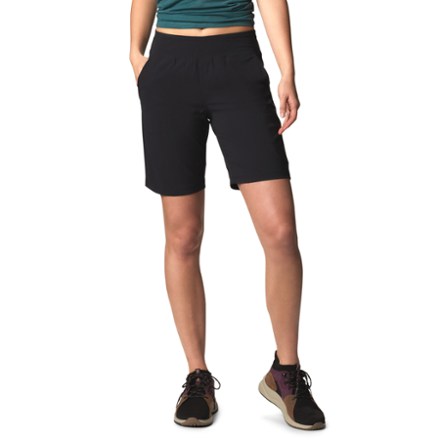Many of us have a warm and cozy relationship with our sleeping bag that we hope will last for many years to come. With these care and cleaning tips, you can make sure you and your bag stay together for the long haul.
Caring For Your Sleeping Bag in Camp
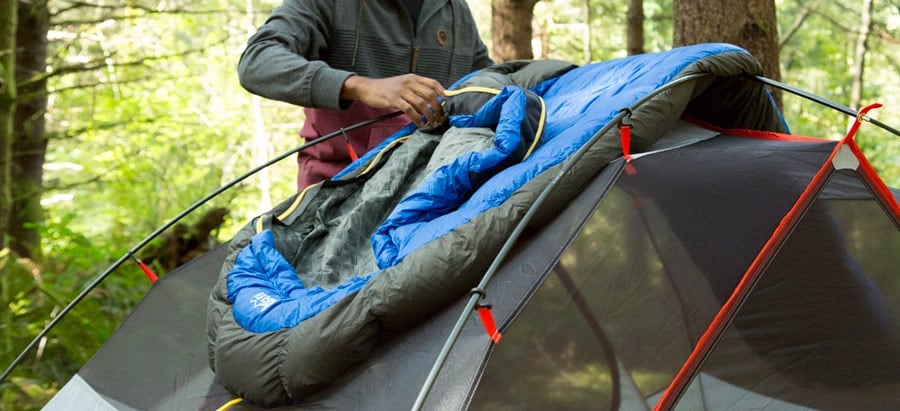
Whether your bag is down or synthetic, it's smart to keep it clean, dry and protected as you camp. It'll last longer and insulate more efficiently. This particularly applies to down sleeping bags, but synthetic bags can also benefit from the following tips.
- Sleep in clean clothes. Even when you're totally exhausted, avoid crawling into your bag wearing the same clothes you hiked in. Over time, body oils, sweat and dirt can rob your sleeping bag of its insulating power. Change into clean long underwear and socks for sleep. If it's warm out, at least wear a clean tee and underwear. A knit cap or clean bandana will keep oily hair off the bag's hood. Sunscreen from your face and neck can soak into your bag, so wash or wipe off any before going to bed.
Also, change out of the clothes you cooked in—especially if you're in bear country. You don't want your sleeping bag to absorb cooking odors, attracting the attention of wildlife.
- Consider using a sleeping bag liner. Liners can be cotton, silk, wool or polyester and are fairly lightweight. They keep your sleeping bag clean because they act as a barrier between your skin and the bag. Plus, they add about 5 to 15 degrees Fahrenheit to your bag's temperature rating. At the end of each trip, simply wash the liner and you're good to go again.
- Protect your bag from the ground. If you plan to sleep out under the stars, put a pad down on the ground first. Some bags feature durable waterproof fabric on the underside, but that needs protection, too, from sharp sticks and conifer pitch.
- Treat it gently. Never jump around camp standing inside your sleeping bag. It'll trash the bag's toe box. If you expect to be sitting by a campfire with your bag wrapped around you for warmth, consider bringing an older synthetic bag. You don't want sparks burning holes in your brand-new down bag.
- Be picky about lending. A friend may want to borrow your favorite sleeping bag, but will they love it like you do? Set some rules, show them how the zippers and cords work, and ask them to use a liner.
- Be patient with zippers. A common frustration is using a two-way zipper; sometimes it'll snag or come apart down by the toe. Get to know your bag's zipper at home and practice using it, so when it's time to zip up in a dark tent, you won't end up yanking on it and causing a fabric tear.
- Air out your sleeping bag daily. Even if you have to wait till midday to do so, turn it inside-out to dry out any moisture. Don't leave a bag in direct sunlight for very long, as UV light slowly degrades the fabric. But if your bag gets really wet, it may be necessary to air it out for several hours. Definitely air out your bag as soon as you get home from a camping trip.
How to Stuff and Store a Sleeping Bag
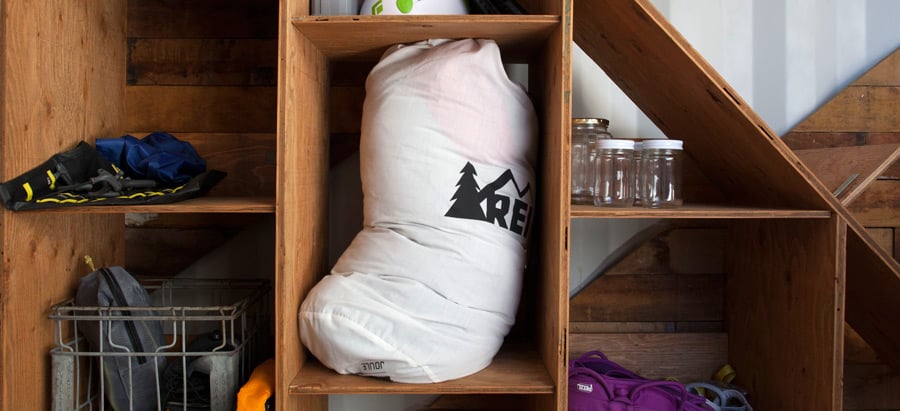
While you're on the trail during your backpacking trip or while driving to your camping destination, you'll likely carry your sleeping bag compactly in a stuff sack. These come in varying sizes (one may come with your sleeping bag), and compression and waterproof stuff sacks are also options.
Tips on using a stuff sack:
- To stuff a stuff sack, start with the foot of the sleeping bag with the zipper partially closed. Push the foot of the bag firmly into the bottom of the stuff sack and stuff evenly as you go up. This releases air out of the top of the bag and puts even stress on the stitching.
- If your bag has a waterproof shell, turn the bag inside out before stuffing. The outer shell can act as a balloon and trap air, a frustrating experience when stuffing.
- Use a slightly larger stuff sack than necessary to make stuffing your sleeping bag easier. It can still be compressed more inside your backpack.
- Compression stuff sacks save even more space in your pack; you stuff the sleeping bag inside, then use built-in straps to compress it even more. Just avoid keeping your bag compressed for an extended period of time as it will reduce the bag's loft.
- Waterproof stuff sacks are great for backpacking when rain is a real possibility, especially if you carry the bag on the outside of your pack. Or you can line a regular stuff sack (or your entire backpack) with a plastic garbage bag and then stuff the sleeping bag inside it. A wet down bag is a sorry sight, and won't keep you warm. A synthetic bag insulates even when damp.
Storing Your Sleeping Bag
How you store your bag affects its lifespan. When you arrive home from a camping trip, unzip the bag and air it out to make sure it's completely dry. Then store loosely in a large cotton or mesh storage sack—which is often included when you purchase a sleeping bag, but also available separately. Or you can use a large pillowcase or sew your own cotton bag.
Do not store your bag compressed in its stuff sack as this will eventually damage the fill. Watertight storage bags are also a bad idea. Condensation can build up inside and result in mildew.
How to Wash and Dry Your Sleeping Bag
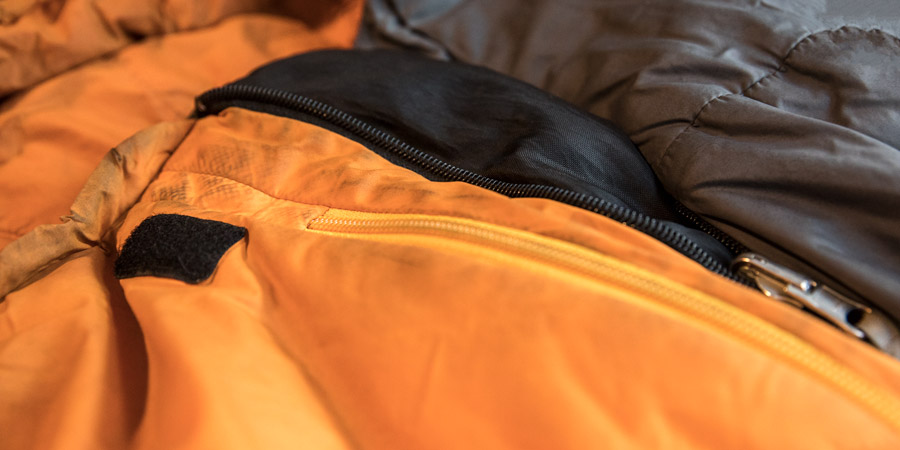
Your care of your bag will vary depending on whether it's down or synthetic. Down requires more time and careful attention, which is why many campers prefer to pay a professional to clean it. But with some thought, you can do it yourself.
Spot Cleaning Your Bag
Sometimes all your bag needs is a little TLC, not a full-blown bath. Because washing a sleeping bag subjects it to wear and tear and decreases the loft, spot cleaning is your first line of defense.
Make a paste of a little non-detergent soap and water and use a toothbrush to gently clean the shell. Focus on the hood and collar where hair and skin oils tend to accumulate. By holding the shell or liner fabric away from the insulation, you can wash and rinse the area without getting the inside fill wet.
Unless the bag has gotten unusually dirty, many years may go by before it'll need a complete wash.
Washing Your Sleeping Bag
If your bag is losing loft and is darkened with grime, then by all means give it a full washing.
First, look to see if the manufacturer's washing instructions are printed somewhere on the bag, either on a tag, draft tube or elsewhere. Follow those instructions.
Many people prefer to have their bag professionally laundered. REI partners with Rainy Pass Repairs to offer a bag-laundering service. This is a great way to protect what can be a major investment.
If you choose to wash and dry your bag yourself, keep in mind that drying alone will take at least two to three hours (down takes a little longer than synthetic). Washing and drying in the large commercial machines at the laundromat may be the easiest way to go. Use a gentle, non-detergent soap that is made for washing down- and synthetic-filled items. Take along a good book. For more details, read How to Wash a Sleeping Bag.
What not to do:
- Never dry clean your sleeping bag. Solvents used in dry cleaning can strip the natural oils from down that help it retain loft.
- Never use fabric softener, bleach or alternative-bleach products.
- Never wash a sleeping bag in a top-loading machine with an agitator. The agitator can strain or rip seams. A top-loader without an agitator is OK.
How to hand wash a sleeping bag:
- Fill the tub with cool or warm water and add the appropriate cleaner for your down or synthetic bag. Avoid using too much soap; if it gets too sudsy, it's harder to rinse out.
- Lay the bag in the water and gently work in the soap throughout the entire bag. Rub together the most heavily soiled areas. Allow it to soak for up to one hour.
- Drain the tub and press out any remaining water.
- Fill the tub with cool or warm water to rinse, work the soap out gently, let the bag sit for 15 minutes and drain. Press out any remaining water. Repeat the rinse process until all the soap is out.
- Gently squeeze out as much water as you can from the bag. Then, work your hands underneath and gather it all up in a ball in your arms to carry it to a dryer. This helps avoid straining and ripping the seams.
- If you have a large dryer at home, use that for drying the bag. If your dryer is so small that the bag stays balled up, you'll need to transport your wet bag to the laundromat.
- If you choose not to use a dryer for your bag, lay it flat on a clean surface outside (such as grass or a beach towel) in the sun or partial shade. You may need to manually break up clumps of insulation as your bag dries.
How to machine wash a sleeping bag:
- Most sleeping bags can be machine washed, as long as a front-loading washer (or top-loading machine without an agitator) is used. Keep in mind that some home front-loaders tend to be small and energy efficient, and may not give your bag enough room to tumble and clean thoroughly.)
- Wash on the gentle cycle in warm (or cold) water with an appropriate soap. Again, use as little as possible to avoid over-sudsing.
- Try adding some other damp articles that need washing, such as a towel or a couple of T-shirts, to help balance the spin of the machine.
- To make sure all the soap residue is gone, rinse at least twice. Or run it a second time through a complete (soap-free) wash-and-rinse cycle.
Drying Your Sleeping Bag
- Set the dryer on low heat. Machine heat varies, so check often. If it's too hot, the fabric or even the synthetic fill can melt.
- When a down bag is nearly dry, add two or three clean tennis balls (or a lightweight pair of clean sneakers) to the dryer. This will help break up any clumps of down as it spins and will help restore the loft.
- Make sure your bag is thoroughly dry before placing it in its storage bag. You can leave it out all night on a bed or hang it up by toe loops, just to be sure.
Other Sleeping Bag Care Tips
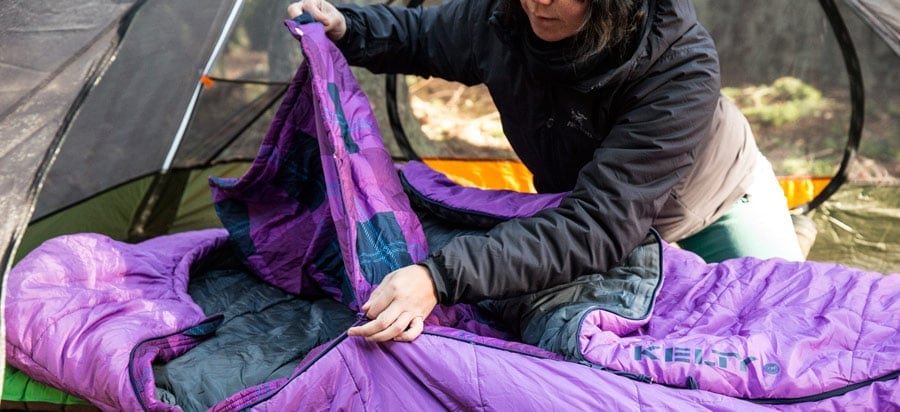
Check your bag periodically to make sure the seams, zippers and drawcords are in good shape. Feel the insulation to see if it's evenly distributed. Over time, down can settle unevenly; sometimes a wash and dry will alleviate that. Here are some other care tips:
Restoring DWR
The original DWR (durable water repellent) finish on a sleeping bag's shell eventually wears off (this may be years, depending on your usage). You can restore water repellency and help keep the bag cleaner if you reapply this finish. There are several products available to restore the DWR to your sleeping bag shell fabric.
Leaking Down
Many, but not all, down bags feature "downproof" liners and shells made of very tightly woven fabric that prevents the down from escaping. If a few feathers make it through the shell or liner of your bag, don't become too concerned. This is normal, especially along the seams. The sharp quills of the feathers may poke through, especially when the bag is new and the down hasn't totally settled. Work the feathers gently back inside, pulling from the opposite side; the holes should be minimal and close back up.
Fabric Tears and Broken Zippers
For small holes or tears that occur in the sleeping bag shell while you're in the field, you have a couple options to keep down insulation from escaping:
- Sew up the hole by hand (keep a needle and thread in your repair kit). When you get home, you can remove the hand stitching and sew the fabric more durably with a sewing machine if you feel confident doing so.
- Make a patch out of adhesive gear-repair tape (cut it rounded, with no sharp corners). However, if you try to peel it off later the sticky adhesive may remain and/or the rip may get worse.
- In a pinch, you can use a wound bandage from your first-aid kit.
If your bag gets a serious hole or broken zipper, consider having it professionally repaired. REI partners with Rainy Pass Repairs to offer a bag-repair service.




